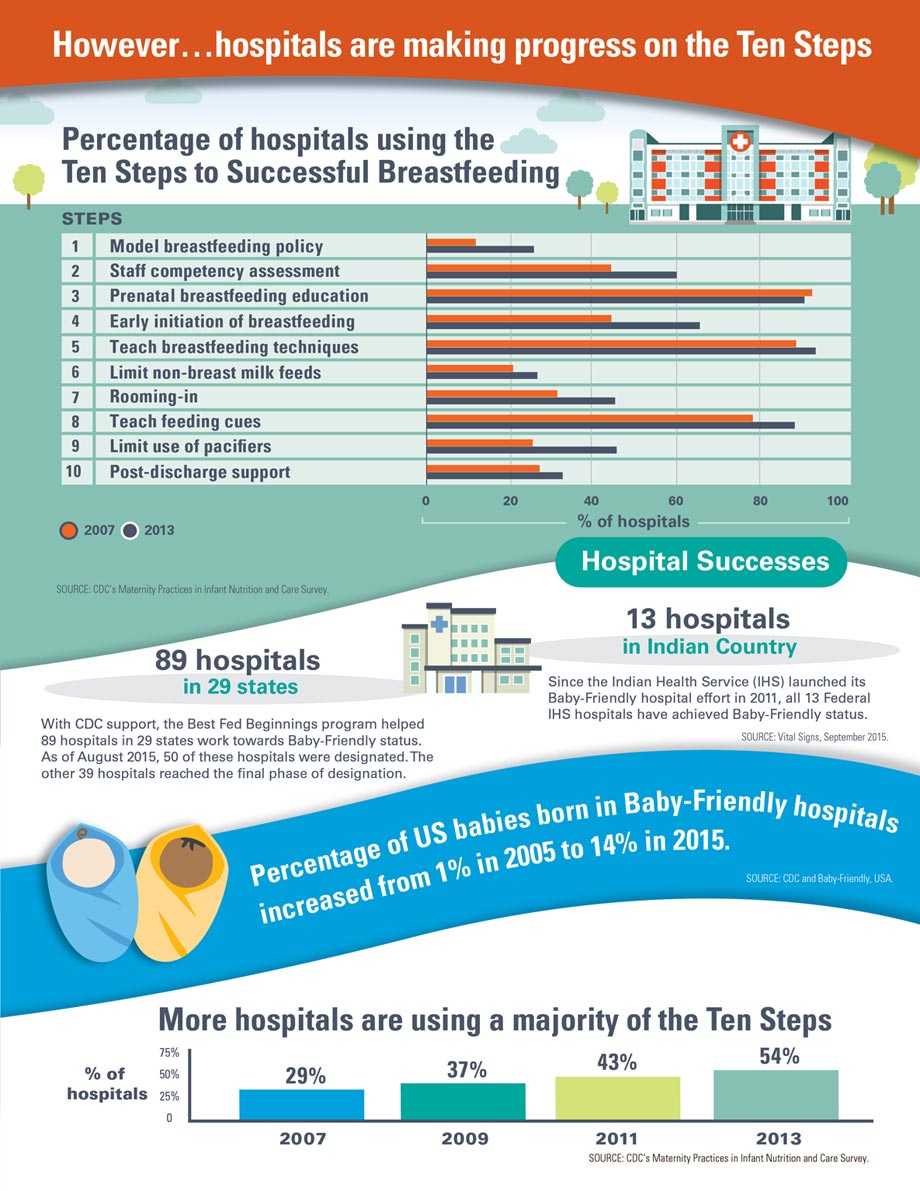Hospital Actions Affect Breastfeeding
Overview
Hospital practices in the first hours and days after birth make the difference in whether and how long babies are breastfed. The WHO/UNICEF Baby-Friendly Hospital Initiative is the global standard for hospital care to support breastfeeding, with the Ten Steps to Successful Breastfeeding at its core.
The percentage of US hospitals implementing a majority of the Ten Steps increased from about 29% in 2007 to nearly 54% in 2013. However, of approximately 3,300 maternity hospitals in the US, only 289 are designated Baby-Friendly. Hospitals influence how the nearly 4 million US babies born each year are fed. Further improvement in hospital practices could increase breastfeeding rates and contribute to better child health.
Hospitals can:
- Implement the Ten Steps to Successful Breastfeeding and work towards achieving Baby-Friendly designation.
- Use CDC’s Maternity Practices in Infant Nutrition and Care (mPINC) survey customized reports to improve maternity care practices that support breastfeeding.
- Work with doctors, nurses, lactation care providers, and organizations to create networks that provide clinic-based, at-home, or community breastfeeding support for mothers.
On This Page
Problem
Practices in many US hospitals do not fully support breastfeeding.
Some of the Ten Steps on which hospitals fell shortest in 2013 included:
- Just 26% of hospitals had a model breastfeeding policy (Step 1).
- Only 26% of hospitals did not routinely feed formula to healthy, breastfed infants when there was no medical reason to do so (Step 6).
- Less than half (45%) of hospitals kept mothers and babies together throughout the entire hospital stay, which provides opportunities to breastfeed and helps mothers learn feeding cues (Step 7).
- Just 32% of hospitals provided enough support for breastfeeding mothers when they left the hospital (Step 10).
Not enough babies are breastfeeding as recommended:
- Only 22% of babies are exclusively breastfed for 6 months as recommended.
- Only 29% are breastfed for 12 months as recommended.
- Babies who are breastfed have reduced risks of ear and respiratory infections, asthma, sudden infant death syndrome (SIDS), diabetes, and obesity.
Infographic
What Can Be Done
The Federal government is
- Helping hospitals become designated as Baby-Friendly through funding and technical assistance.
- Supporting state health departments to help hospitals improve maternity care practices.
- Tracking hospital policies and practices that support breastfeeding using CDC’s Maternity Practices in Infant Nutrition and Care (mPINC) survey to evaluate federal, state and local efforts.
- Making breastfeeding counseling and supplies available to families with no out-of-pocket cost through a health insurance plan provision of the Affordable Care Act.
States and local government can
- Adopt standards for hospitals to support breastfeeding.
- Help hospitals implement the Ten Steps to Successful Breastfeeding.
- Help hospitals connect mothers to community programs for support once they leave the hospital.
Hospitals can
- Implement the Ten Steps to Successful Breastfeeding and work towards achieving
Baby-Friendly designation. - Use CDC’s Maternity Practices in Infant Nutrition and Care (mPINC) survey customized reports to improve maternity care practices that support breastfeeding.
- Work with doctors, nurses, lactation care providers, and organizations to create networks that provide clinic-based, at-home, or community breastfeeding support for mothers.
Healthcare providers can
- Help write hospital policies that support mothers and babies to breastfeed.
- Counsel mothers on breastfeeding during prenatal visits.
- Include lactation care providers and other breastfeeding experts on patient care teams.
- Support breastfeeding in the hospital and at well-baby visits.
Mothers and their families can
- Talk to their healthcare providers about breastfeeding plans, and ask about how to get help with breastfeeding.
- Ask about breastfeeding support practices and Baby-Friendly designation when choosing a maternity hospital.
- Join with other community members to encourage local hospitals to improve breastfeeding support and become Baby-Friendly.
Issue Details
Related Pages
- Vital Signs Issue details: Improvements in Maternity Care Policies and Practices That Support Breastfeeding — United States, 2007–2013, Morbidity and Mortality Weekly Report (MMWR)
- Vital Signs – Hospital Actions Affect Breastfeeding [PODCAST – 1:15 minutes]
- Vital Signs – Hospital Actions Affect Breastfeeding [PSA – 0:60 seconds]
- CDC breastfeeding
- CDC’s mPINC Survey
- Rates of breastfeeding nationally and by state (National Immunization Survey)
- DNPAO’s Data, Trends and Maps database
- Page last reviewed: October 6, 2015
- Page last updated: October 6, 2015
- Content source:
- Centers for Disease Control and Prevention, National Center for Chronic Disease Prevention and Health Promotion
- Page maintained by: Office of the Associate Director for Communications (OADC)


 ShareCompartir
ShareCompartir


